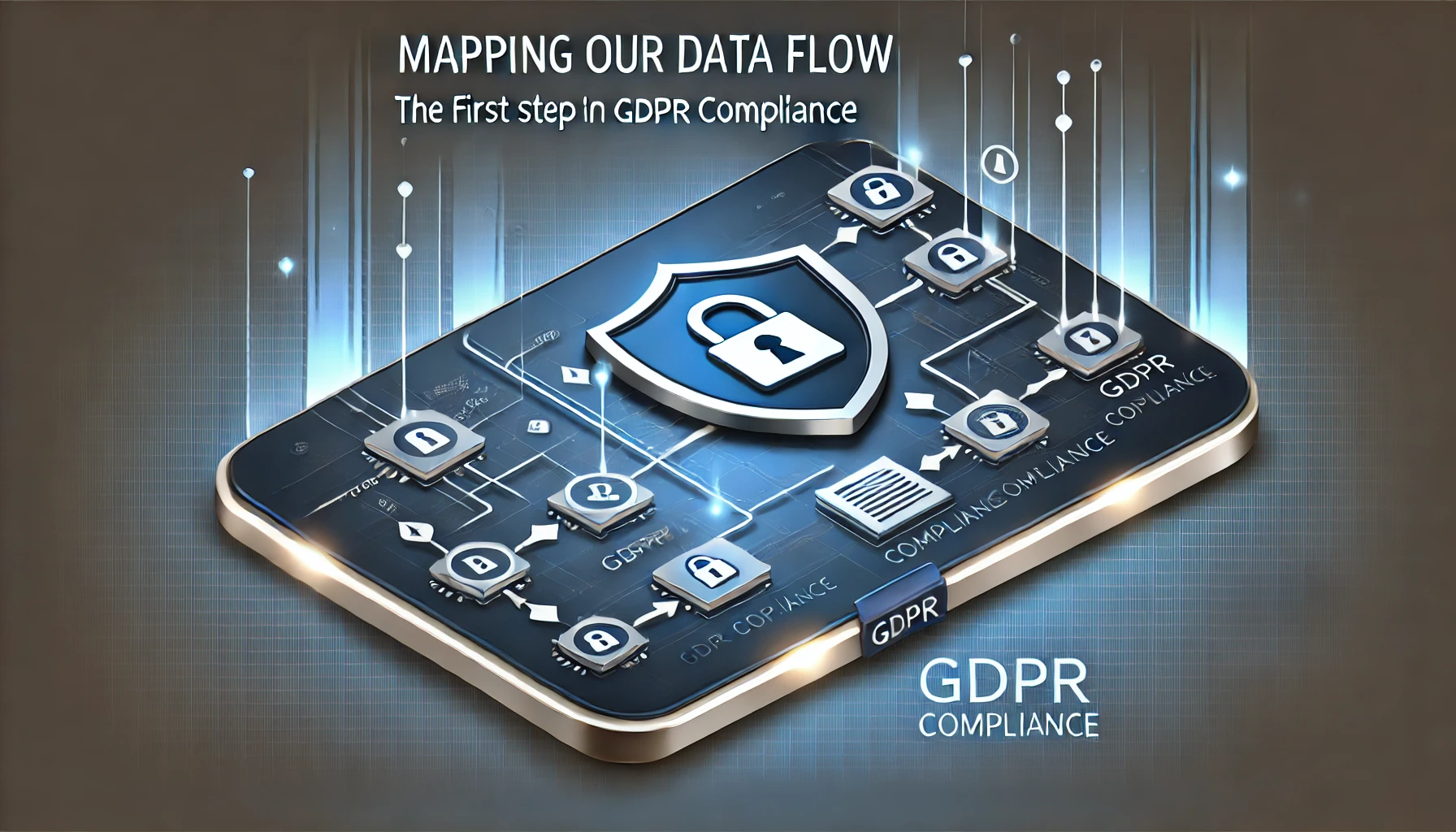Understanding where and how data moves through our system was the first step in ensuring GDPR compliance at Transcribe Monkey. Data flow mapping is not just a regulatory necessity; it’s a foundational practice that ensures transparency, security, and trust. In this post, we’ll walk through our comprehensive data flow mapping process, from initial data collection to storage and eventual deletion. We’ll explain the tools and methodologies we used to visualize data touchpoints and how this exercise helped us identify potential risks and areas for improvement. Transparency is key to GDPR, and by mapping our data flow, we laid the foundation for a system that users can trust.
Why Data Flow Mapping is Essential for GDPR Compliance
Under GDPR, organizations are required to understand and document how personal data flows through their systems. This is critical for several reasons:
- Transparency: GDPR mandates that organizations provide clear information to users about how their data is processed. Data flow mapping helps us deliver on this promise.
- Risk Identification: By visualizing the movement of data, we can identify potential vulnerabilities and areas where data protection measures need to be strengthened.
- Accountability: Data flow maps serve as documentation that we can present during audits to demonstrate our commitment to GDPR compliance.
- Improved Processes: Understanding our data flow allows us to streamline operations, eliminate unnecessary data processing, and enhance overall efficiency.
The Data Flow Mapping Process at Transcribe Monkey
Our data flow mapping process was meticulous and thorough, ensuring that every data touchpoint was identified and documented. Here’s a step-by-step look at how we approached this critical task:
- Identifying Data Sources
The first step was to identify all the sources from which personal data enters our system. This includes:
- User Inputs: Data provided directly by users when they sign up, upload audio files, or interact with our platform.
- Third-Party Integrations: Data received from third-party services such as payment processors and cloud storage providers.
- System-Generated Data: Metadata and logs generated by our system during user interactions.
- Documenting Data Collection Points
Once we identified the data sources, we documented every point where data is collected. This includes:
- Registration Forms: Collection of user names, email addresses, and passwords.
- Audio Uploads: Collection of audio files and associated metadata.
- Payment Information: Collection of billing details through secure payment gateways.
- Mapping Data Processing Activities
For each data collection point, we documented how the data is processed. This includes:
- Transcription: Processing audio files to generate text transcriptions.
- User Authentication: Verifying user credentials for secure access.
- Analytics: Aggregating anonymized data for performance monitoring and improvement.
- Identifying Data Storage Locations
We identified where each type of data is stored, ensuring that storage solutions meet GDPR’s security requirements. This includes:
- Cloud Storage: Secure storage of audio files and transcriptions on GDPR-compliant cloud servers.
- Local Databases: Storage of user account information in encrypted databases.
- Third-Party Services: Secure handling of payment information by PCI-compliant payment processors.
- Tracking Data Transmission
We mapped how data moves between systems, both internally and externally. This includes:
- Internal Transfers: Movement of data between our application servers, databases, and analytics tools.
- External Transfers: Data transmitted to third-party services, such as cloud storage providers and payment gateways.
- Data Encryption: Ensuring all data transmissions are encrypted using industry-standard protocols like TLS.
- Mapping Data Retention and Deletion
We documented our data retention policies to ensure compliance with GDPR’s storage limitation principle. This includes:
- Retention Periods: Defining how long different types of data are retained.
- Automated Deletion: Implementing automated processes to delete data when it’s no longer needed.
- User-Initiated Deletion: Providing users with tools to request data deletion in compliance with their right to be forgotten.
Tools and Methodologies Used
To create comprehensive and accurate data flow maps, we utilized a combination of tools and methodologies:
- Data Flow Diagrams (DFDs): Visual representations of data movement using standardized symbols to depict processes, data stores, and data flows.
- Unified Modeling Language (UML): Diagrams that help visualize the system architecture and data interactions.
- Spreadsheet Documentation: Detailed spreadsheets listing all data sources, processing activities, storage locations, and transmission paths.
- Automated Monitoring Tools: Software that tracks data flow in real-time, helping us identify and document dynamic data interactions.
Key Findings and Improvements
Our data flow mapping exercise revealed several important insights and opportunities for improvement:
- Unnecessary Data Collection: We identified instances where more data was being collected than necessary. By eliminating these unnecessary data points, we reduced our data footprint and enhanced privacy.
- Security Enhancements: Mapping data flow highlighted areas where additional security measures were needed, such as encrypting data at rest and implementing multi-factor authentication.
- Improved Data Access Controls: We refined our access control policies to ensure that only authorized personnel have access to sensitive data.
- Streamlined Data Processes: Understanding data flow allowed us to streamline our processes, reducing redundancies and improving efficiency.
The Role of Data Flow Mapping in Transparency and Trust
Transparency is a cornerstone of GDPR, and our data flow mapping efforts play a crucial role in building trust with our users. By clearly understanding and documenting how data moves through our system, we can:
- Provide Clear Privacy Policies: Our privacy policies are based on accurate data flow information, allowing us to clearly explain to users how their data is processed.
- Respond to Data Subject Requests: We can quickly and accurately respond to user requests for data access, correction, or deletion.
- Demonstrate Compliance: During audits or regulatory reviews, our data flow maps serve as evidence of our commitment to GDPR compliance.
- Build User Confidence: Knowing that we have a clear and secure data flow process in place reassures our users that their data is handled responsibly.
Continuous Improvement and Monitoring
Data flow mapping is not a one-time exercise; it’s an ongoing process that requires continuous monitoring and updates. At Transcribe Monkey, we:
- Regularly Update Data Flow Maps: We review and update our data flow maps whenever new features are added, or processes change.
- Monitor Data Flow in Real-Time: We use automated tools to monitor data flow in real-time, quickly identifying and addressing any anomalies.
- Conduct Periodic Audits: Regular audits ensure that our data flow processes remain compliant with GDPR and aligned with best practices.
- Engage in Continuous Training: Our team receives ongoing training to stay updated on data protection regulations and practices.
Conclusion
Mapping our data flow was the first and most crucial step in our journey towards GDPR compliance at Transcribe Monkey. This comprehensive process allowed us to visualize how data moves through our system, identify potential risks, and implement robust safeguards. By prioritizing transparency and continuously monitoring our data flow, we’ve built a foundation of trust and accountability. Our commitment to data protection is unwavering, and data flow mapping remains a key pillar of our privacy-first approach. Through these efforts, we ensure that our users can rely on Transcribe Monkey not only for accurate transcriptions but also for the secure and responsible handling of their personal data.

